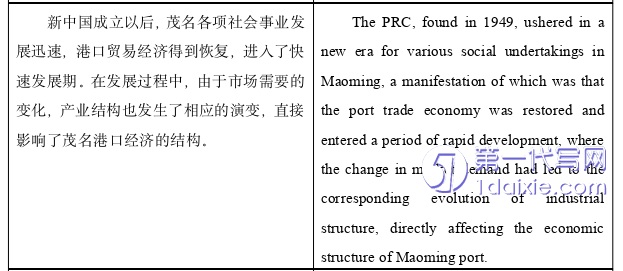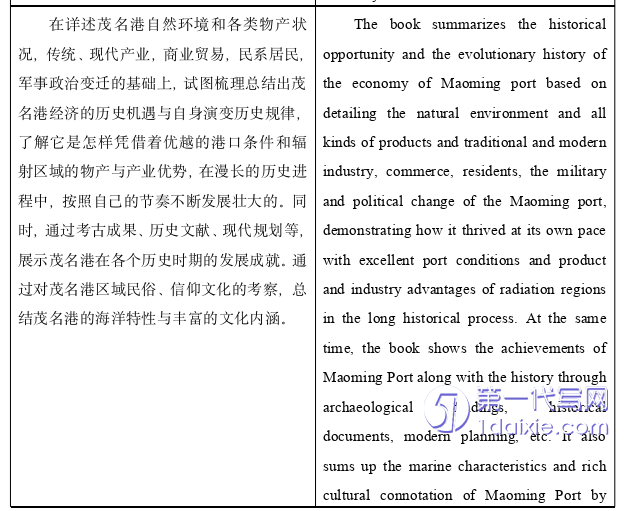本文是一篇英语论文,本文是基于《茂名港与海上丝绸之路》的汉译英翻译实践报告。内容涉及广东省茂名市茂名港自新中国成立以来及“一带一路”背景下发生、发展、盛衰变化的历史过程、特点和规律及相关海陆资源对城市发展的影响等方面。
Chapter One Task Description
1.1 Introduction to Translation Task
The translated material was taken from the book Maoming Port and theMaritime Silk Road by Li Aijun,a Ph.D.supervisor in Human Geography at SunYat-sen University.The author chose the Introduction and the fifth section of Chapter4,“Maoming Port Economy and Trade since the Founding of New China”as thetranslation materials,totaling 1,0829 words.The reasons the author chose the Introduction and“Maoming Port Economy andTrade since the Founding of New China”are mainly considered from two aspects:thedegree of importance and the difficulty of the text.

The Introduction is the guide thatleads the reader into the text.It provides a general introduction to the origins ofMaoming Port and summarizes its positioning and development in the modern Beltand Road Initiativeeconomy.The Introduction gives the reader an overall grasp of thetext and a better understanding of what follows.“Maoming Port Economy and Tradesince the Founding of New China”is the core of the book,as it focuses on the recovery and development of the Maoming Port trade economy since the founding ofNew China.Therefore,the author has chosen these two parts as translation materials.
1.2 Translation Process
The translation is a rigorous and complex language conversion activity,whichcan be divided into three stages:pre-translation,while-translation and post-translation.The three stages are not only sequential,but also interlinked,influencing each otherand together determining whether the translation ultimately achieves the unity ofscience and artistry.
1.2.1 Pre-translation
Pre-translation is the first task in the translation process.Adequatepre-translation helps to improve the speed and quality of the translation.Therefore,after determining the original text,the first step is to draw up a translation plan so thatthe translator can control the progress of the translation according to the schedule.

Chapter Two Source Text Analysis
2.1 Brief Introduction to the Content
This paper is a Chinese-English practice report on the development of MaomingPort in Maoming City,Guangdong Province,from Li Aijun's Maoming Port and theMaritime Silk Road.The selected material focuses on the historical process,characteristics,and patterns of the emergence,development,prosperity,and declineof Maoming Ports,providing a series of historical profiles of its evolution.Based on adetailed description of the natural environment and various types of products,traditional and modern industries,commerce and trade,the population,and militaryand political changes,the text summarizes the opportunities and the evolutionaryhistory of the economy of Maoming Port,showing readers achievements it has madesince the founding of New China.

2.2 Features of Source Text
It is particularly important to be familiar with the original work and never tiredof reading it.The basic law of translating is never to do it until we get a hang of theoriginal text.Only when we know the original by heart can we start our translationwork.Fu Lei stressed the importance of understanding the original text beforetranslation,and emphasized that if one cannot read the original text thoroughly andfully comprehend its meaning and style,one cannot be good up to the work oftranslation.It is thus clear that a thorough analysis of the original text is the foundation of translation activities.Therefore,the author first analyzed the text type,linguistic,and discourse features of the original text before starting the translation.
Firstly,in terms of lexical level,the original text has a wide variety of words:firstly,there are culturally loaded words with Chinese characteristics,such as“市舶司”,“承包责任制”,“冼夫人”,“妃子笑”,etc.;secondly,there are words withvery regional characteristics of western Guangdong,such as“年例”.In addition,thefrequent use of the four-character form is also a feature of the original language,which adds to the linguistic cohesion and graphic content of the text.For example,indescribing Maoming's maritime landscape of salt fields,the words“围漏环抱、池沟交错、港汊纵横、蜿蜒起伏”are used in succession;in describing the developmentof Maoming's handicraft industry,the original text uses words such as“引资嫁接、灵变闯海”to express the author's appreciation of Maoming.The richness anddiversity of the vocabulary of the original text have,to a certain extent,shaped itslinguistic style with regional characteristics.However,as the vocabulary betweenEnglish and Chinese is not entirely equivalent,the translation of Chinese words intoEnglish is inevitably faced with the fact that there exists the absence of equivalents,multiple meanings,and multiple synonyms.Therefore,how to select and constructwords to reproduce the language style of the original is one of the difficulties oftranslation.
Chapter Three“Three Closeness”Principle for International Publicity..................10
3.1 Background of the Principle...................................11
3.2“Three Closeness”Principle.............................12
Chapter Four Case Analysis Based on“Three Closeness”Principle.........................12
4.1 Lexical Level Translation...........................12
4.1.1 Terms........................................13
4.1.2 Cultural-loaded Words......................................16
Conclusion............................34
Chapter Four Case Analysis Based on“Three Closeness”Principle
4.1 Lexical Level Translation
The original text has a wide variety of vocabulary types,with culturally loadedwords,words with regional characteristics and four-character words appearingfrequently,so how to select and construct words to accurately convey the meaning isa major difficulty in translation at the lexical level.
In international publicity translation,the method of translation and interpretationshould be done in parallel.As the explanatory translation of things,phenomena,andconcepts unfamiliar to readers has been done by adding background,it will helpimprove the clarity and communication effect of overseas-targeted publicitytranslation(Lu,2012).Therefore,the translator complements literal translation andfree translation with each other,as well as translation and interpretation in parallel,inthe form of adding notes(literal translation with notes and transliteration with notes),adding necessary explanations or background interpretation into the translation with the help of definite clauses,cognates,background notes,etc.,to supplement andannotate the relevant contents of the original text,which makes it easy for targetreaders to understand and accept,and realizes the principle of“being close to thethinking habits of target readers”.
Conclusion
As the main part of this practice report,the fourth chapter of the case studyfocuses on the difficulties encountered by the author in the translation process,suchas cultural-loaded words,long sentences,and the cohesion of sentences.Guided bythe principle of being close to the thinking habits of target readers when translating,the translator flexibly adopts translation methods and techniques such as translationand interpretation at the lexical,syntactic and textual level,and analyses the specificcases.
No study seems perfect;similarly,there are some limitations in the thesis:theauthor still falls short in the transmission of cultural imagery and fails to fullyreproduce the cultural charm of the original text.The translator is aware that she hassome difficulties in understanding and translating cultural-loaded words andfour-character words,so there is still room for improvement in the use of some wordsand phrases in the translation.
Based on the findings in this thesis,here are some suggestions on C-Etranslation in Maoming city image promotion.To begin with,in the translationprocess,expressions must be authentic and standard,in line with English expressions.Mechanical reproduction of the linguistic structure of the source language is strictlyforbidden.In terms of word choice,attention should be paid to the expectations andpurposes of the Maoming Port publicity,and if necessary,the information conveyedshould be adjusted accordingly to conform to the authenticity of the original text.Furthermore,C-E translation is about conveying information and expressing opinionsrather than simply doing a translation of the language.Translators must be aware ofthe characteristics of both languages in every respect and carefully consider thecultural and social differences involved.Based on a full understanding of the originaltext,appropriate translation strategies must be adopted to help the audienceunderstand the image of international communication.
reference(omitted)
